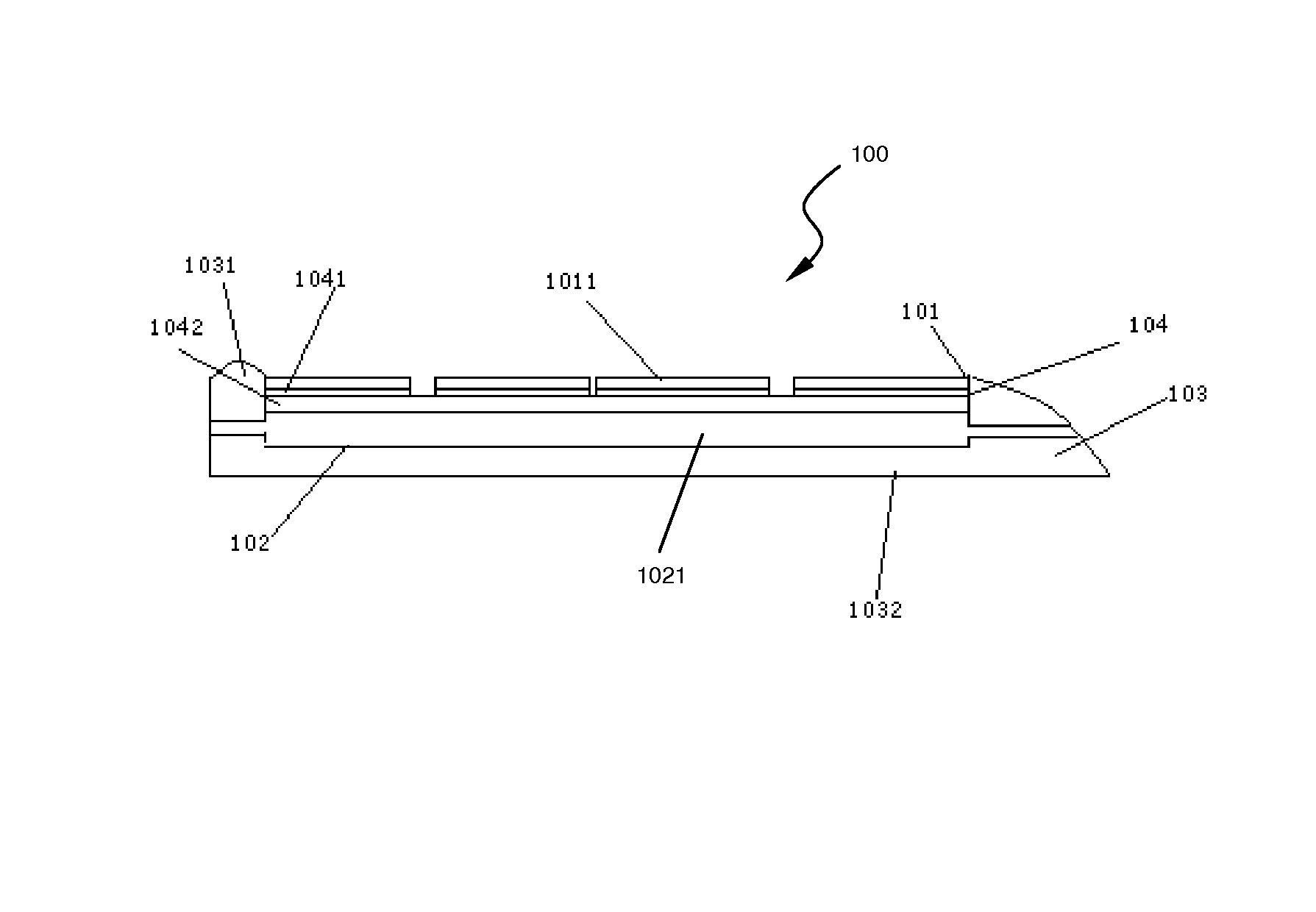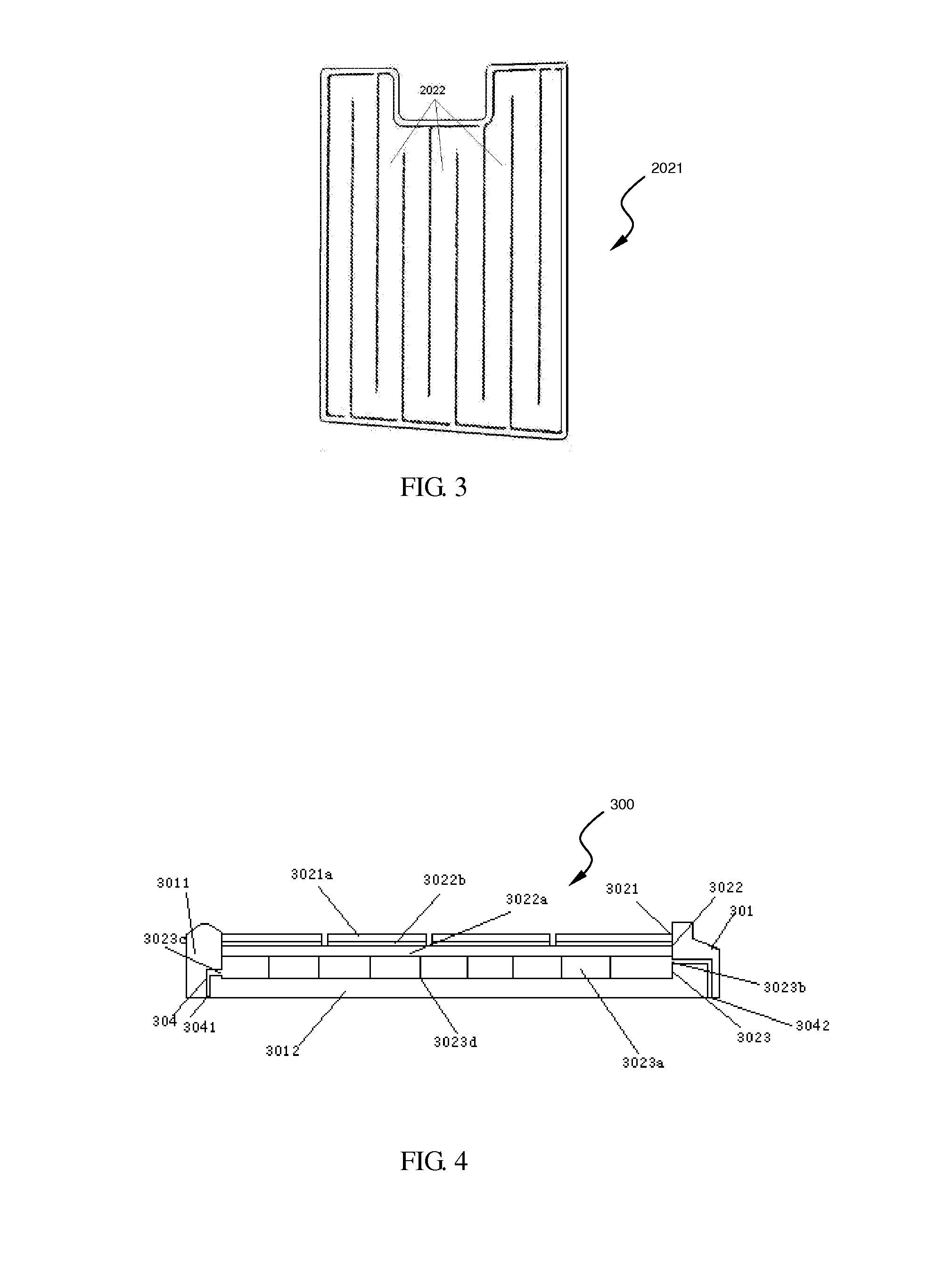Solar tile
- Summary
- Abstract
- Description
- Claims
- Application Information
AI Technical Summary
Benefits of technology
Problems solved by technology
Method used
Image
Examples
first embodiment
[0081]FIG. 1 shows a sunlight tile of the present invention. The sunlight tile 100 comprises: a solar energy converting unit 101, a cooling unit 102, an insulating heat conduction layer 104 and a tile body 103.
[0082]The tile body 103 can be integral and molded of a refractory flame-retardant unsaturated modified synthetic engineering plastic.
[0083]As shown in FIG. 1, the solar energy converting unit 101 is disposed on a surface of the tile and can be a single silicon cell or an array comprised of a plurality of silicon cells 1011, and a light permeable hydrophobic film layer (not shown) can be provided on a light receiving surface of the solar energy converting unit 101.
[0084]The insulating heat conduction layer 104 comprises a ceramic membrane layer 1041 and a metal heat conduction binding layer 1042, wherein the metal heat conduction binding layer 1042 can be formed of conductive silver paste. A backlighting surface of each silicon cell 1011 is applied to a screen printed metal he...
second embodiment
[0089]As shown in FIG. 2, in the present invention, the sunlight tile 200 comprises a solar energy converting unit 201, a heat absorbing assembly 202, an insulating heat conduction layer 204 and a tile body 203.
[0090]The sunlight tile in the second embodiment is substantially identical with the tile body in the first embodiment in structure, and the only thing is that the heat absorbing assembly 202 replaces the cooling unit 102 of the first embodiment. The heat absorbing assembly 202 is supported by the tile body 203 and disposed on a backlighting surface of the solar energy converting unit 201. As shown in FIG. 2, the heat absorbing assembly 202 can be an integrally formed groove plate 2021 which can be an aluminum substrate, so it has a good heat conduction performance.
[0091]In one embodiment of the present invention, the groove plate 2021 can be a transverse through groove which is wholly recessed, a thickness of the through groove is by far smaller than its length, and oil or w...
third embodiment
[0093]As shown in FIGS. 4-6, in the present invention, the sunlight tile 300 comprises a tile body 301, a solar energy converting assembly 302, an electrical output unit 303 and a heat transfer unit 304.
[0094]As shown in FIG. 4, the solar energy converting assembly 302 is supported by the tile body 301 and comprises a photovoltaic power generating unit 3021, an insulating heat conduction layer 3022 and a heat absorbing unit 3023.
[0095]As shown in FIGS. 5 and 7, the photovoltaic power generating unit 3021 is disposed on the surface of the tile body 301, and its light receiving surface may have a light permeable hydrophobic film layer (not shown). The photovoltaic power generating unit 3021 comprises a plurality of silicon cells 3021a which light receiving surface is a negative pole and which backlighting surface is a positive pole. The plurality of silicon cells 3021a are connected together in series. For example, as shown in FIG. 7, in an array with four columns and six lines of sil...
PUM
 Login to View More
Login to View More Abstract
Description
Claims
Application Information
 Login to View More
Login to View More - R&D
- Intellectual Property
- Life Sciences
- Materials
- Tech Scout
- Unparalleled Data Quality
- Higher Quality Content
- 60% Fewer Hallucinations
Browse by: Latest US Patents, China's latest patents, Technical Efficacy Thesaurus, Application Domain, Technology Topic, Popular Technical Reports.
© 2025 PatSnap. All rights reserved.Legal|Privacy policy|Modern Slavery Act Transparency Statement|Sitemap|About US| Contact US: help@patsnap.com



